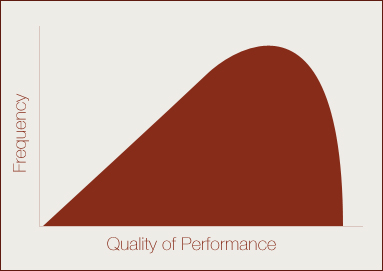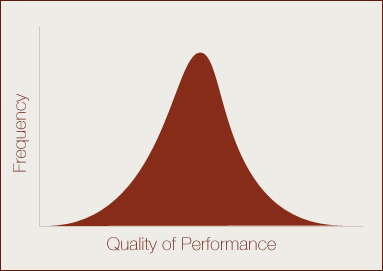
Why Everyone Loves the Underdog & What Your Company Can Learn From It
Last night's NCAA basketball championship was a classic sports event. It had all the necessary ingredients. A big stage. A real-life match up of David vs. Goliath. A sports powerhouse against an up & coming private school. It was the film hoosiers come to life (minus the fact the underdog lost on the final shot).
While I was rooting for Duke, having been born and raised in North Carolina during the 1990's, almost everyone else was rooting for Butler. The reason is simple. Butler was the underdog, and humans have an innate love of the underdog.
Psychologists call it the underdog effect. They refer to is as the activation of the underdog schema. This occurs whenever we see a disadvantaged opponent. We root for the gazelle when it's chased by lions. Put simply, we root for anyone attempting to accomplish a difficult task in the face of low odds.
But why do humans have an underdog schema? The answer is two-fold. The first reason is: we strive to be unique, and who we root for sends a signal to the rest of the world. If the obvious choice is Duke, then it's best to root for Butler. After all, there's nothing really at stake in fandom. So the need to be different makes us more likely to root against the "popular" choice.
The second reason is that humans are naturally empathetic. It's a capability that allows us to live effectively as a social animal. Compassion is hard-wired into humanity. And empathy allows us to put ourselves in the shoes of the underdog. We identify with them, and seek to translate their accomplishments to our own. If David can beat Goliath, than I too can overcome impossible odds.
But, the underdog effect isn't limited to sports. We root for companies just like we root for teams. Apple, Dyson, Method, Virgin Airlines, Mini, etc. These brands are effective because they position themselves as challengers, not leaders. Choosing a product from one of these companies tells the world that you're not like everyone else (despite the fact 300,000 other people have the exact same iPad).
While people love underdogs, they never choose them in the face of their own self-interest. You never take a mortgage out with a struggling bank, and you never buy a house in a half-built community.
So how do the successful underdogs do it? They succeed because they create products that are superior when viewed through their particular worldview. Is Method's hand soap better than Dial? It's more expensive, but you probably wouldn't consider it better unless you have the same worldview as they do (sustainability=good & chemicals=bad).
Underdog companies don't compete on features. They compete by aligning with your worldview and creating products that fit your personal definition of a better product.
Shark Fins & Bell Curves: Why You Think You're Above Average
Most people think of their performance curve as a shark fin. They believe they do excellent work most of the time, average work sometimes and substandard work very occasionally.

However, this is a classic case of illusory superiority bias in action (it's the same reason 75% of people rate themselves as above average drivers).
The reality is: your performance curve is much more likely to resemble a bell curve than a shark fin.

But, this doesn't mean you can't improve. You can. Through deliberate practice (challenging yourself and gathering feedback), you can move the bell curve to the right. You're essentially changing the frame of reference that you use to rate yourself. By trying to make sure each subsequent performance is better than the last performance, you can slowly move the bell curve.
For example, you may think you're a great basketball player. But, compared to the average player in the NBA you're terrible. On their worst day they're still exponentially better than you are on your best day. The same holds for golf, marketing strategy or design.
You have to compare yourself to people that are better than you. This requires a humility that some people can't stomach. It's hard to admit that you're not as good as you think you are (or as good as you pretend to be). But, that's the only way you can move the bell curve to the right.
Ever see one of Hitler's paintings?
You know, Hitler wanted to be an artist. At eighteen he took his inheritance, seven hundred kronen, and moved to Vienna to live and study. He applied to the Academy of Fine Arts and later to the School of Architecture.
Ever see one of his paintings? Neither have I. Resistance beat him. Call it overstatement, but I'll say it anyway: it was easier for Hitler to start World War II than it was for him to face a blank square of canvas.
-Steven Pressfield, The War of Art
Viral Marketing 101: The Difference Between Viral Memes & Viral Platforms
There are two types of viral. Viral memes and viral platforms.
Viral memes are things like subservient chicken, and email chains about rat feces in your coke can. They spread quickly because they hit a nerve in popular culture. They're shooting stars. They spread fast and then they disappear. This is natural. After all, when's the last time you watched "David at the Dentist", or any of the other viral hits of the past year?
Too often Interactive marketers try to create the next big viral meme. They want to make the next "elf yourself" or the next "subservient chicken." But, time and time again, they fail. They fail because memes are unpredictable. They require an adoption by the greater culture that is completely random. This doesn't mean brands shouldn't create fun and entertaining content. They should, but they shouldn't create it because they want it to go viral. They should create it because it has value. Because it makes people smile, it communicates a product benefit or because it's strikes a chord with their target audience.
The opposite of the viral meme is the Viral Platform. Viral platforms are unique because they become more useful as more people join. Think flickr, facebook, paypal, or even farmville (a viral game platform built on top of an already existing viral platform). Viral platforms exhibit the same rapid growth rate as viral memes, but they have staying power. Since their utility increases as more people join, their growth leads to stickiness. These positive network effects create a feedback loop that leads to rapid growth, rapid adoption and long term utility. And amazingly, their growth rates are almost completely predictable. Once you know the viral coefficient, you can model their growth up until they reach the saturation point.
Unfortunately, most marketers don't understand the difference between these two approaches. If you want to create a successful viral campaign/business, the first step is deciding which of these two approaches you want to take. Both approaches can work, but you need to be realistic in your expectations. Meme's are great, but you have to throw a lot of stuff against the wall to try to get something to stick. There are no guarantees. Viral platforms are more predictable and long lasting because of their positive network effects, but it takes a lot more effort to create them. They have to provide utility, or fill a need. But, if you can create a successful viral platform, the efforts can be well worth the investment.
Mastery vs Performance Goals: Why the Type of Goal You Set Matters
Everyone sets goals. But, what most people don't realize is that the type of goals you set can have a major impact on your long term performance.
The most basic type of goal is known as a performance goal. These are goals that are directly correlated to an outcome. You want to get an "A" on that spanish test, or hit your sales quota.
These goals can be great in the short term, but they also have some downsides. Performance goals by their nature are rather shallow. If you had to cheat, at least you still hit your goal. If you made a mistake in the sales process, well at least you still hit your quota.
Performance goals also tend to undermine long-term performance. If you hit your initial goal, you become less motivated to continue towards excellence (after all you hit your goal). And if you don't hit your initial goal, you become discouraged and de-motivated because your self-worth is based on external inputs.
On the other side of the goal-setting coin are what's know as mastery goals. A mastery goal is when you set out to become the best you can be at a single task. Instead of trying to get an "A" in spanish, you try to become fluent in spanish.
Behavioral Researchers have found that mastery goals are more effective because your satisfaction isn't related to external indicators. Therefore you're less apt to give up in difficult circumstances, and you persevere through setbacks.
Mastery goals are always just beyond reach. This makes motivation over the long term easier to maintain. They're like a line that's asymptote. The curve of the line gets closer to the goal, but you never quite reach it. There is always something to strive for.
People that reach the pinnacle of their skills rarely set performance goals. They're more interested in competing with themselves, than gaining external feedback and validation. This orientation allows them to compete at a higher level over a longer period of time.
With Mastery goals there's always something to strive for. Even if it's as simple as being better at something tomorrow, than you were today.